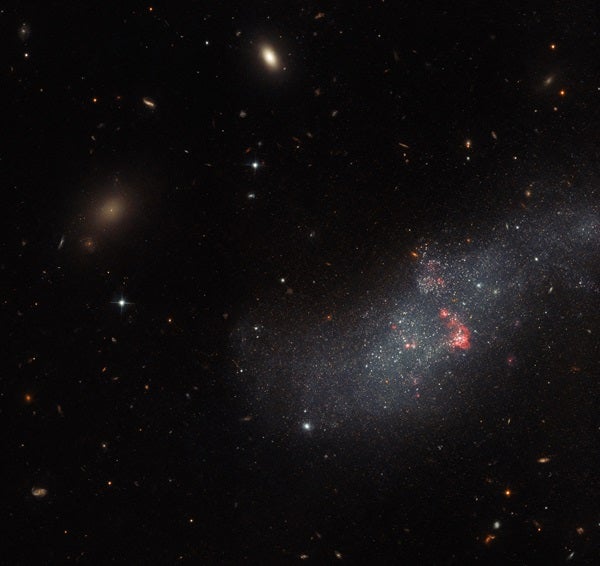
The Hubble Space Telescope has been scouring the heavens from space for more than 30 years, making it one of the greatest success stories in astronomy.
Sure, the James Webb Space Telescope has been dominating the headlines lately. But ever since Hubble launched in 1990, the telescope has captured countless iconic images that have wowed millions, if not billions, of people. And it’s still going strong.
The latest notch in Hubble’s belt is the stunning image above, which captures a tiny, diffuse galaxy named UGCA 307. The galaxy is located some 26 million light-years from Earth in the constellation Corvus the Crow.
This diminutive galaxy displays an amorphous shape that’s nothing like the intricate spiral structure found in many larger galaxies, including our Milky Way and the nearby Andromeda Galaxy. Instead, UGCA 307 appears as little more than a small, fuzzy patch of stars.
Nonetheless, the new Hubble image does confirm that even this diffuse dwarf galaxy can form new stars. Within the hazy body of UGCA 307, Hubble picked up several enormous bubbles of hot gas (seen in red) that are bursting with star formation.
Dwarf galaxy UGCA 307 is thought to orbit the much larger and well-structured Sombrero Galaxy, much like the Large Magellanic Cloud orbits the Milky Way. In turn, UGCA 307 and the Sombrero make up a large cluster of galaxies on the southern edge of the even larger Virgo Supercluster. The Virgo Supercluster contains many thousands of galaxies, including our own Local Group, and some research suggests it is actually just one lobe of an even larger assemblage of galaxies known as the Laniakea Supercluster, which contains hundreds of thousands of galaxies.
Hubble captured the new image of UGCA 307 using its Advanced Camera for Surveys (ACS), which astronauts installed during Servicing Mission 3B in 2002. Unlike the James Webb Space Telescope, which operates nearly a million miles from Earth at a special spot called the second Lagrange point (L2), Hubble operates in low Earth orbit, roughly 330 miles (530 km) above Earth’s surface. This low orbit makes it possible for astronauts to visit, repair, and refurbish Hubble, which they did during five separate space shuttle missions carried out between 1993 and 2009.
The UGCA 307 image is not one of Hubble’s longer exposures, however. Instead, it’s akin to a snapshot. That’s because Hubble captured the image as part of an appropriately named survey program called The Every Known Nearby Galaxy Survey.
This program is an effort to get consistent Hubble data for as many of the Milky Way’s galactic neighbors as possible. Before the survey, Hubble had previously imaged some 75 percent of known galaxies within about 33 million light-years of Earth. The survey is intended to flesh out that sampling with roughly 150 snapshots of the remaining camera-shy galaxies.
Completion of The Every Known Nearby Galaxy Survey would not only provide a valuable archival record of nearly all nearby stars in the local universe. It would also reveal information on stellar demographics throughout a multitude of different galaxies, as well as provide astronomers with a more clear and complete picture of our cosmic neighborhood’s structure.









